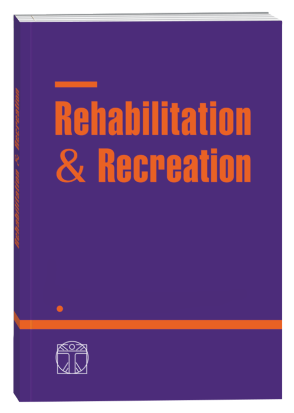POSSIBILITIES OF CORRECTION OF VERTEBROGENIC DISORDERS AS A COMPONENT OF HIP-SPINE SYNDROME IN ELDERLY PERSONS WITH OSTEOARTHRITIS OF THE HIP AND SARCOPENIC OBESITY BY MEASURES OF PHYSICAL THERAPY
DOI:
https://doi.org/10.32782/2522-1795.2024.18.3.2Keywords:
physical therapy, sarcopenia, obesity, osteoarthritis, hipAbstract
Purpose – to determine the effect of a physical therapy program on the vertebrogenic symptoms of hip-spine syndrome in elderly people with osteoarthritis of the hip, which occurs against the background of sarcopenic obesity. Material. 68 elderly people with osteoarthritis of the hip and sarcopenic obesity and 36 of their healthy peers (control group) were examined. Representatives of the comparison group (33 people) corrected the signs of osteoarthritis according to the clinical guideline “Osteoarthrosis”. The representatives of the main group (35 people) were engaged in a physical therapy program for six months using therapeutic exercises, functional training, Proprioceptive Neuromuscular Facilitation, massage, kinesiological taping; course of shock wave therapy, nutrition correction, patient education. The effectiveness of the program was evaluated by the dynamics of the results of questioning, examination, palpation, flexibility of the spine (Schober, Thomayer, Sedin tests), standing dynamometry, Oswestry Disability Index. Results. In elderly patients with osteoarthritis of the hip and sarcopenic obesity, signs of hip-spine syndrome were determined in the form of pain syndrome in the hip and lower back, limitation of their mobility (according to the results of questioning, examination, palpation), a decrease in the flexibility of the spine (according to the tests of Schober, Thomayer, Sedin), deterioration of the strength of trunk extensor muscles (according to static dynamometry), which negatively affected the performance of activities of daily life (according to the Oswestry Disability Index). The tested comprehensive program of physical therapy revealed a statistically significant improvement in the condition of patients due to the impact on the components of the hip-spine syndrome due to the reduction of pain and the improvement of the mobility of the lumbar and hip, the improvement of the flexibility of the spine, the increase of standing strength, the expansion of motor functional capabilities when performing various activities in comparison with initial indicators for all studied parameters (р<0,05). Patients who underwent rehabilitation according to the standard program for the correction of osteoarthritis achieved a statistically significant improvement relative to the initial state according to the studied indicators of the hip-spine syndrome (p<0.05), however, less pronounced compared to the tested program, created from the position of correcting the features of comorbidity and geriatric status. Conclusions. Elderly patients with osteoarthritis of the hip and sarcopenic obesity need the development of physical therapy programs taking into account and correcting the specifics of the hip-spine syndrome, which increases the overall effectiveness of rehabilitation.
References
Клінічна настанова «Остеоартроз», 2017. URL: https://www.dec.gov.ua/wp-content/uploads/2019/11/akn_osteo.pdf.
Aravitska M.H., Saienko O.V. The influence of physical therapy on indicators of locomotive syndrome in elderly persons with osteoarthritis of the knee and obesity. Clinical and Preventive Medicine. 2023. 4(26). 6–13. DOI: https://doi.org/10.31612/2616-4868.4(26).2023.01.
Chavarria J.C., Douleh D.G., York P.J. The Hip-Spine Challenge. J Bone Joint Surg Am. 2021. 103(19). Р. 1852–1860. DOI: 10.2106/JBJS.20;.01728.
Cruz-Jentoft A.J., Bahat G., Bauer J., et al. Sarcopenia: revised European consensus on definition and diagnosis. Age Ageing. 2019. 48(1). Р. 16–31. DOI: 10.1093/ageing/afy169.
Didokha I.V., Aravitska M.G., Yatsiv Ya.M., Hrecheskyi O.V. Effect of a physical therapeutic intervention on locomotive syndrome in the elderly patients with Parkinson’s disease and sarcopenia. Health, sport, rehabilitation. 2023. 9(1). 55–68. DOI: https://doi.org/10.34142/HSR.2023.09.01.05.
Fairbank J.C.T., Pynsent P.B. The Oswestry Disability Index. Spine (Phila Pa 1976). 2000. 25(22). Рp. 2940–53. DOI: 10.1097/00007632-200011150-0001.
Kechagias V.A., Grivas T.B. Hip-Spine and Knee-Spine Syndrome: Is Low Back Pain Improved After Total Hip and Knee Arthroplasty? Cureus. 2024. 16(4). Р. e57765. DOI: 10.7759/cureus.57765.
Kechagias V.A., Grivas T.B., Papagelopoulos P.J, Kontogeorgakos V.A., Vlasis K. Investigation of the Relationship Between Hip and Knee Osteoarthritis and Disordered Spinal and Pelvic Morphology. Cureus. 2022. 14(1). Р.e20861. DOI: 10.7759/cureus.20861.
Koval N.P., Aravitska M.H. Dynamics of kinesiophobia and physical functioning parameters in the elderly adults with sarcopenic obesity under the influence of the physical therapy program. Clinical and Preventive Medicine. 2023. 4(26). 88–95. DOI: https://doi.org/10.31612/2616-4868.4(26).2023.13.
Lementowski P.W., Zelicof S.B. Obesity and osteoarthritis. Am J Orthop (Belle Mead NJ). 2008. 37(3). Рp. 148–151.
Makolinets K.V., Makolinets V.I., Morozenko D.V., Gliebova K.V., Danylchenko S.I. Dynamics of biochemical markers of connective tissue metabolism in patients with knee osteoarthritis during conservative treatment with laser therapy. Wiadomości Lekarskie. 2019. LXXII (5). Рp. 802–806.
Merle C., Akbar M. Hip-Spine-Syndrom. Orthopade. 2020. 49(10). Рp. 839–840. DOI: 10.1007/s00132-020-03988-4.
Offierski C.M., MacNab I. Hip-spine syndrome. Spine (Phila Pa 1976). 1983. 8(3). Р. 316–321. DOI: 10.1097/00007632-198304000-00014.
Sampath S.J.P, Venkatesan V., Ghosh S., Kotikalapudi N. Obesity, Metabolic Syndrome, and Osteoarthritis-An Updated Review. Curr Obes Rep. 2023. 12(3). Р. 308–331. DOI: 10.1007/s13679-023-00520-5.
Zimmerer A., Hoffmann M., Hofer A., Janz V., Wassilew G.I. Hip-Spine-Syndrom – Aktuelle Entwicklungen und Evidenzlage [Hipspine syndrome-current developments and state of the evidence]. Orthopade. 2020. 49(10). 841–848. DOI: 10.1007/s00132-020-03972-y.
Downloads
Published
How to Cite
Issue
Section
License
Copyright (c) 2024 A. S. Kravets, E. Y. Lapkovskyi, M. Р. Stovban

This work is licensed under a Creative Commons Attribution-NonCommercial-NoDerivatives 4.0 International License.












